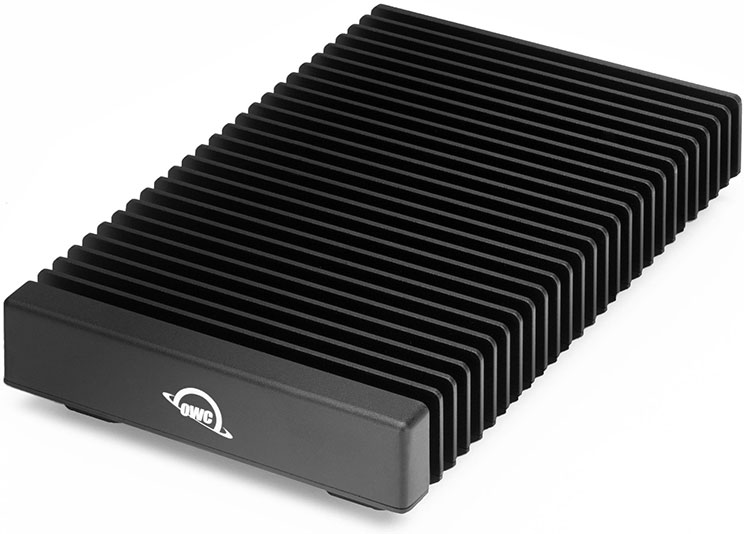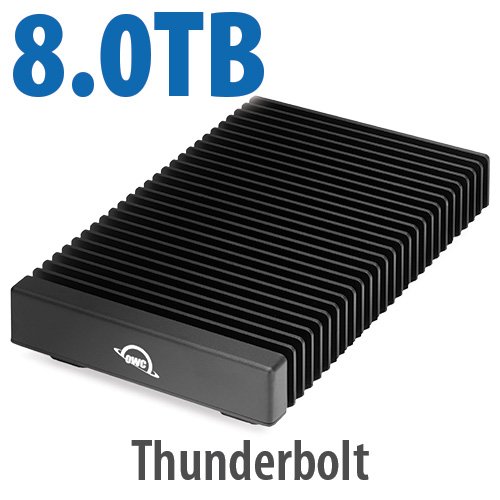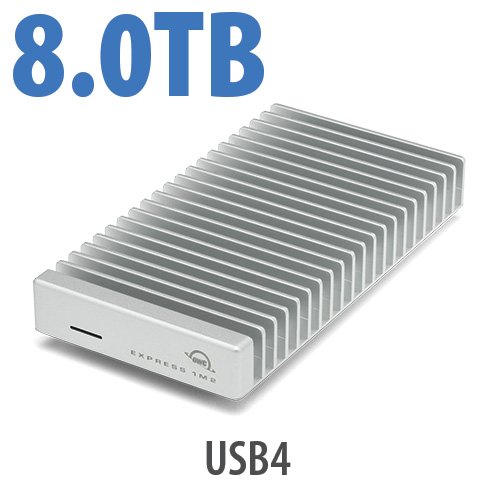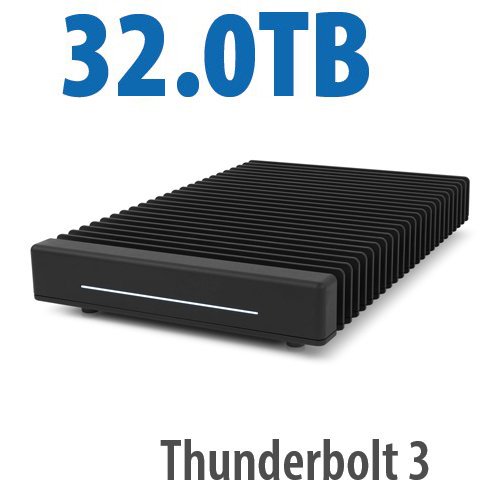
|

|

|

|

|

$220 SAVE $130 = 37.0% Western Digital 16.0TB Western Digital Ultrastar DC HC550 3.5-in… in Storage: Hard Drives
|

|

|

|

|
OWC ThunderBlade X8 Thunderbolt SSD RAID-0, RAID-5
Related: backup, bandwidth, diglloydTools, DiskTester, fault tolerance, Java, Other World Computing, OWC Express 1M2, OWC Thunderblade, RAID, RAID-0, RAID-4, RAID-5, SoftRAID, SSD, storage, Thunderbolt, Thunderbolt 3, USB, USB4, weather events
MPG tested the 8TB OWC ThunderBlade X8.
The original OWC ThunderBlade ("ThunderBlade X4") with 4 SSD 'blades' offered up to 32TB capacity. I own two of them (8TB each), and they still run like champs for me ~5 years later.
In early 2024, the OWC ThunderBlade X8 takes the concept to a new level, with 8 internal SSD blades and significantly faster performance* with capacity options of 8/16/32TB.
- Up to 2840MB/s Read & 2821MB/s Write*
[MPG: actual figures up to 10% higher than claimed] - Daisy chain up to 6 Thunderbolt devices
- Rugged portability in a sleek design
- Includes a custom-fit ballistic hard-shell case
- Includes SoftRAID XT: robust software for creating, monitoring, and managing advanced RAID sets
- 3 Year OWC Limited Warranty
The ThunderBlade X8 enclosure is little changed in size because its 8 NVMe M.2 2242 SSD blades (22 X 42mm) are about half the size of the NVMe M.2 2280 blades (22 X 80mm) in the OWC ThunderBlade X4.
* The arrival of Thunderbolt 5 in 2024... when will the ThunderBlade X8 be updated for Thunderbolt 5? That would double its peak speed.
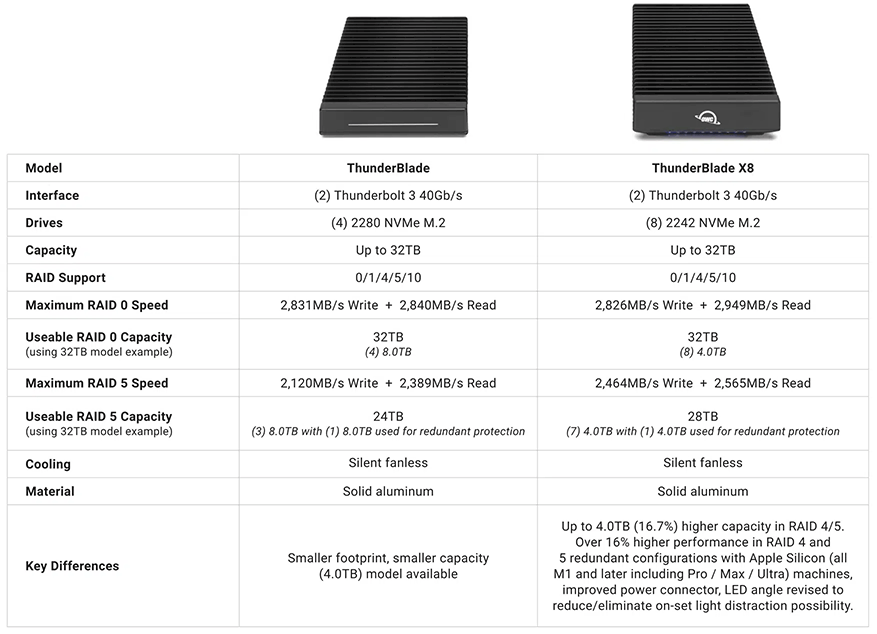
Silent high performance convenience
The capacity options of 16TB and 32TB are incredible in historical terms: ~3 GB/sec performance across 16/32TB of capacity opens up new possibilities for photo and video professional, or for anyone who just wants to dispense with noisy hard drives for main storage.
As a photographer, all the images shot in my entire life will fit within the 16TB ThunderBlade—and I shoot a lot and have more images than 99% of my readers.
Putting it into numbers: the 100-megapixel Fujifilm GFX100 produces 16-bit raw files that average 124MB each. Rounding the 15.36TB capacity to 15TB, the 16TB ThunderBlade can hold ~121000 raw files at 124MB each. For Sony A7R IV files, that figure rises to ~242000 raw files at 61.9MB each. Few photographers will push beyond that capacity.
Run silent and run fast with the OWC ThunderBlade X8, and backup to the OWC Thunderbay 4.

RAID support
Options include the following RAID modes:
RAID-0 striping for max capacity and performance
For my usage, maximum speed and capacity are the priority. Blade failures should be rare, and RAID is not and never has been a backup. I keep several backups.
RAID-4/5 for fault tolerance
Fault tolerance via RAID-4/5 parity mode allows one (1) blade to fail without losing any data. There is a loss of 1/8 of the capacity and 1/8 of the performance. This is a big improvement over the 25% (1/4) loss with the ThunderBlade X4.
While blade failure should be rare, it cannot be ruled out and therefore a 'production' setup might find this quite appealing, particularly in the field where things can get bumped and banged. OTOH, RAID is not and never has been a backup. Where data survival is critical, there had better be backups as well.
RAID 1+0 (stripe of mirrors) for more fault tolerance
RAID 1+0 (stripe of mirrors) results in half the usable capacity but is tolerant of 2 or 3 blade failures. IMO, RAID 1+0 is unwarranted to the point of silliness, because the physical risks to the device itself are surely much higher than multiple blade failures. RAID 1+0 might make sense for hard drives but not for SSD blades. And maybe anyone needing that capability is better off with dual 4-blade ThunderBlades (two independent units rather than one unit).
Formatting the OWC ThunderBlade
ThunderBlade X8 ships with SoftRAID XT, with the 8 SSD blades configured as a RAID-0 stripes shown, delivering 7.68TB = 6.99 TiB* usable capacity.
Toggle to see the RAID-0, RAID-4, RAID10 setup.
TB = 1000^3, TiB = 1024^3
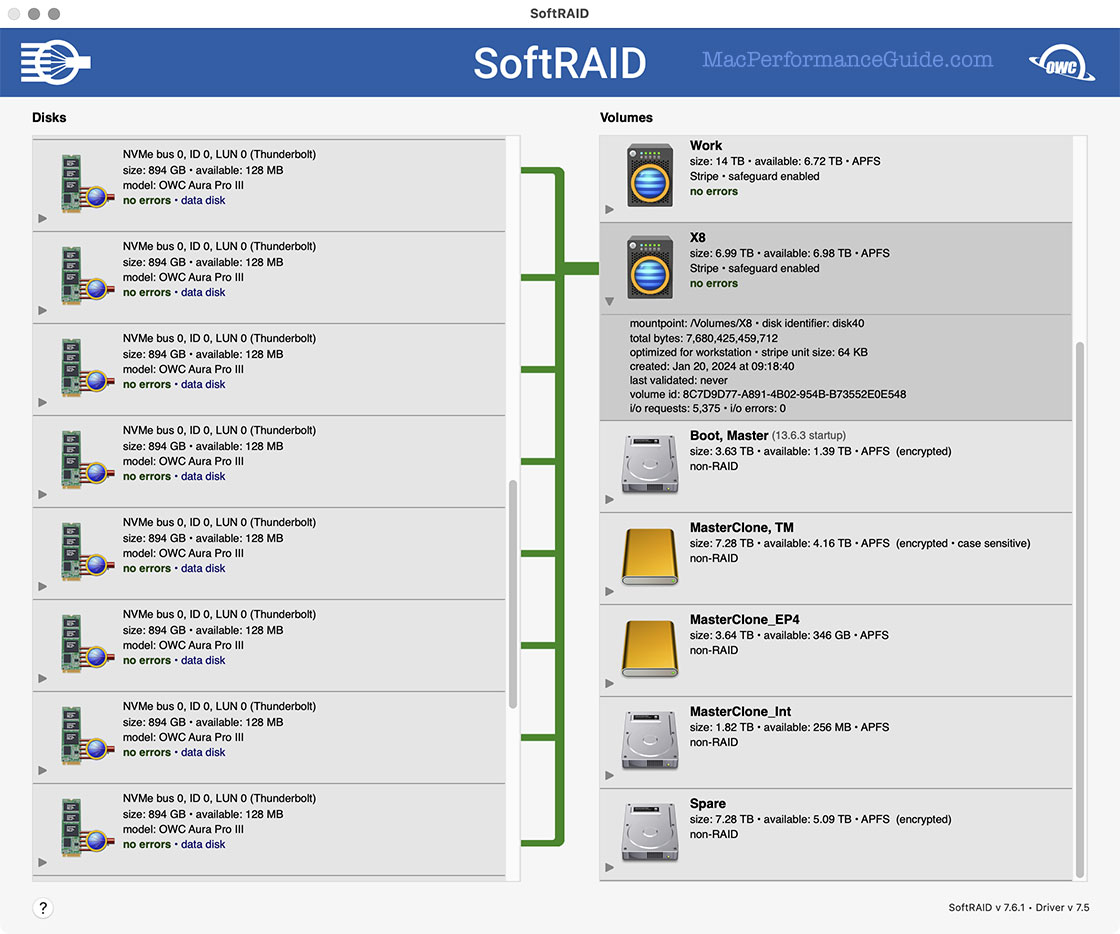
Performance: speed over entire capacity, RAID-0 vs RAID-4
Tested with the fill-volume command of diglloydTools DiskTester.
disktester fill-volume
A brutal test... the ThunderBlade X8 became slightly warm, but never hot.
Performance bumps up against the limits of the Thunderbolt 3/4 bus*. Only a USB4 SSD like the OWC Express 1M2 can go faster, but the X8 is a Thunderbolt device, not USB4.
Thunderbolt 5 arrives in 2024 with double the bandwidth. Presumably OWC will deliver a Thunderbolt 5 version of the X8 at some point, but the company has not stated any timeframe.
As expected, RAID-4 (same as RAID-5 functionally) sees a 12.5% performance decline (1/8) from RAID-0. This is expected since reading the parity information (1 blade of 8) drops the actual data that is read/written to 7/8 that of RAID-0.
RAID-0 write: 2822 MiB/sec = 2890 MB/sec
RAID-0 read: 2917 MiB/sec = 2987 MB/sec
RAID-4 write: 2468 MiB/sec = 2527 MB/sec
RAID-4 read: 2617 MiB/sec = 2617 MB/sec
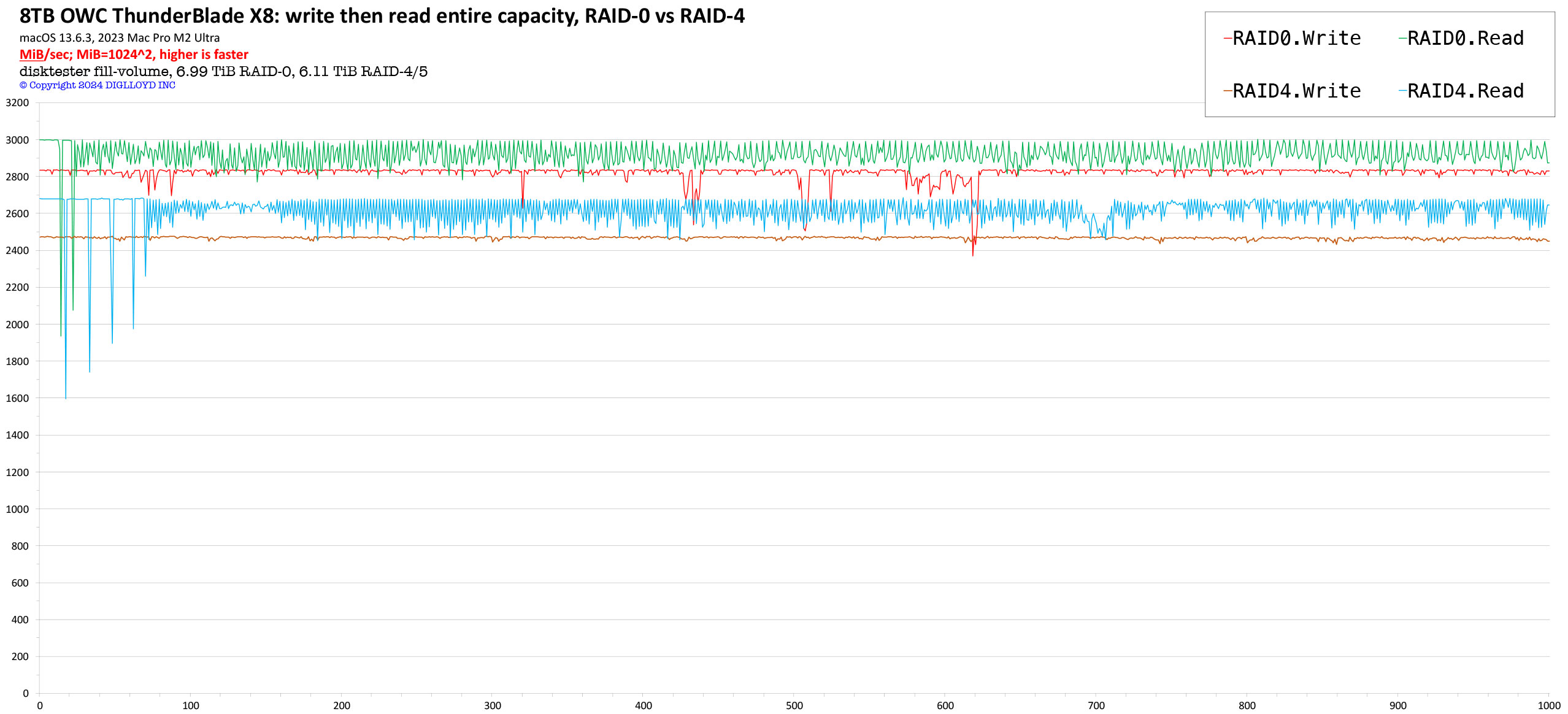
The same type of test was run with dtj (DiskTester Java), which uses different buffering. Similar results were seen. Note that all these tests are pounding the ThunderBlade X8 as hard as possible for writes and it holds up great.
RAID-0 write: 2793 MiB/sec = 2860 MB/sec
RAID-0 read: 3026 MiB/sec = 3098 MB/sec
RAID-4 write: 2405 MiB/sec = 2463 MB/sec
RAID-4 read: 2700 MiB/sec = 2765 MB/sec
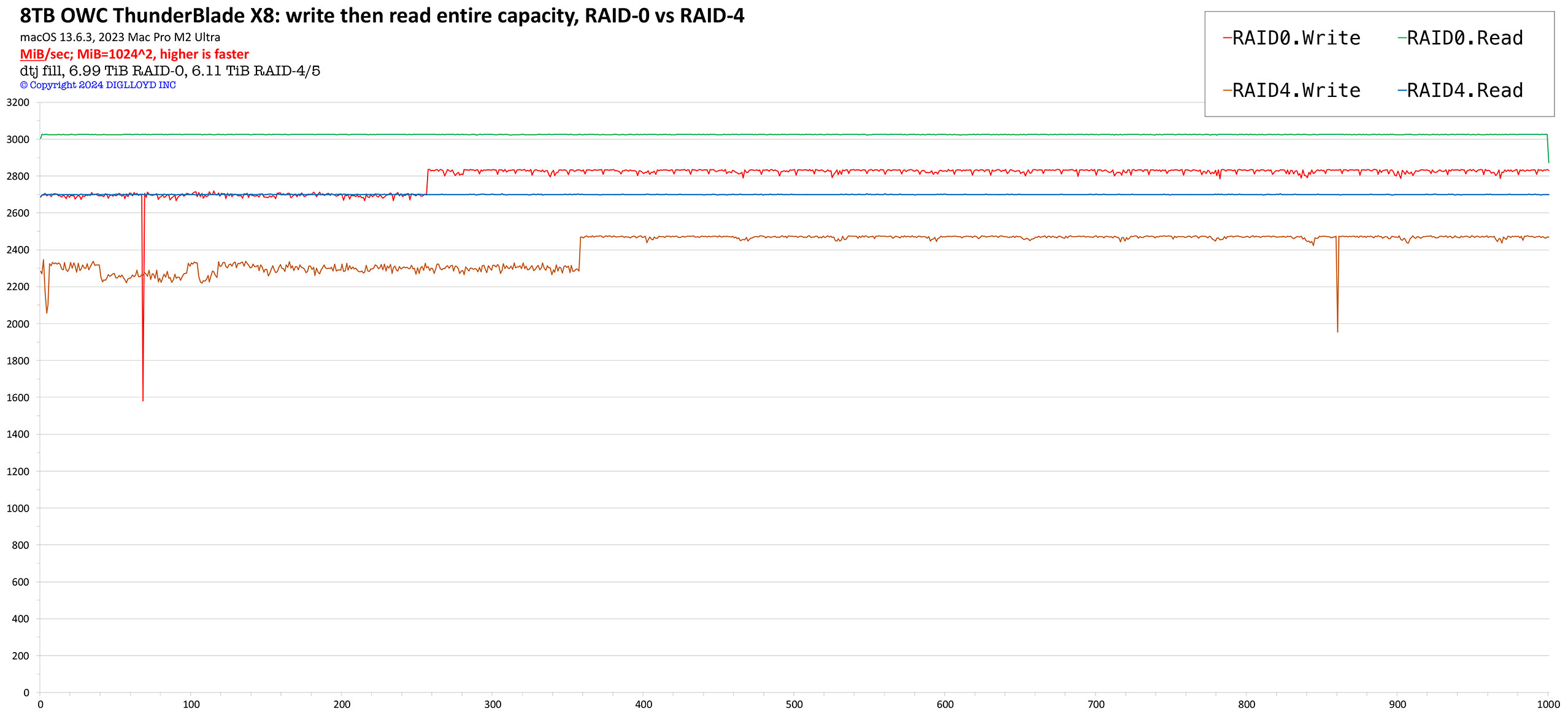
Performance: single SSD blade
Tested with the fill-volume command of diglloydTools DiskTester.
disktester fill-volume
For this test, a single SSD blade (1 of 8) was tested. Speed is quite modest, for unknown reasons possibly having to do with the way PCIe lanes are mapped to each individual blade (?).
My interest was in seeing the potential performance should a Thunderbolt 5 version of the ThunderBlade X8 become available.
Total potential bandwidth: 6.2 GiB/sec write and 6.4 GiB/sec read — which (just) matches or exceeds the bandwidth of even Thunderbolt 5 — looks future=proof.
Write: 778 MiB/sec = 797 MB/sec
Read: 803 MiB/sec = 822 MB/sec
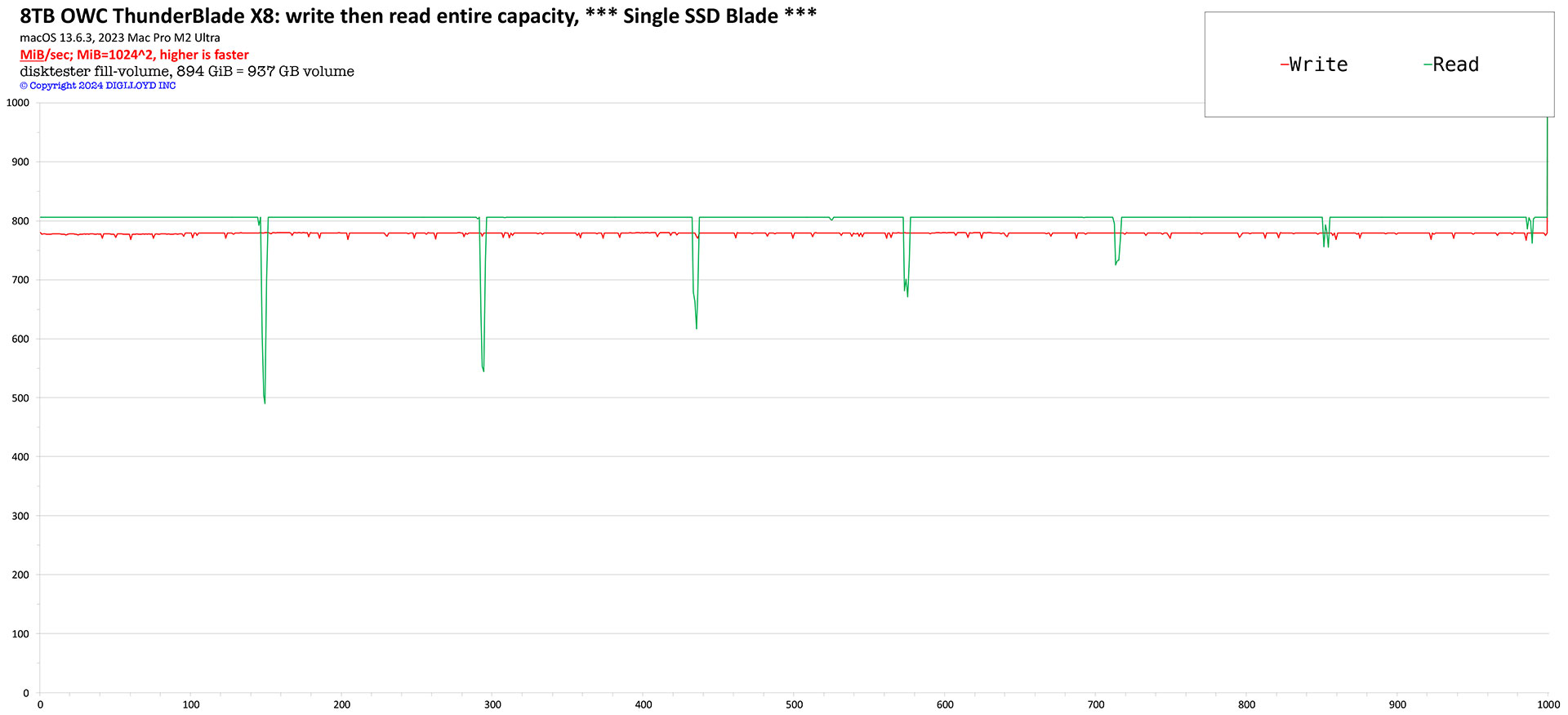
Performance: speed vs transfer size, RAID-0 vs RAID-4
Tested with the run-sequential-suite of diglloydTools DiskTester.
disktester run-sequential-suite
Write speed is superb, presumably because of caching in the I/O stack, or perhaps the SSD itself.
Read speed cannot be cached so it behaves differently.
With RAID-0 and a stripe size of 64 KiB, 32 KiB and 64 KiB transfers involve only one of the blades. Not until 512 KiB transfers (64K X 8) are used can full striping take place. But larger transfers are needed to fully exploit the speed.
With RAID-4 and a stripe size of 16 KiB, transfers are only marginally slower than RAID-0. Not until 16 MiB (very large!) transfer sizes are seen does RAID-4 fall behind appreciably, and then it is only about 13% slower.
Bottom line: in terms of performance, RAID-4 see little practical downside.
RAID-5 (distributed parity) was also tested, but performed the same as RAID-4 (dedicated parity drive).
Figures in MiB/sec (1024*1024/sec); multiple by 1.048 for MB/sec (1000*1000/sec).

Performance: data integrity verification
Tested with verify command of IntegrityChecker Java
icj verify
Here the OWC Express 1M2 outperforms the ThunderBlade X8. That’s apparently because USB4 for single blades can use a slightly faster bus protocol.
The difference is not significant for real-world use, amounting to 8.9% faster with the 8TB Express 1M2.
Figures in MiB/sec (1024*1024/sec); multiple by 1.048 for MB/sec (1000*1000/sec).
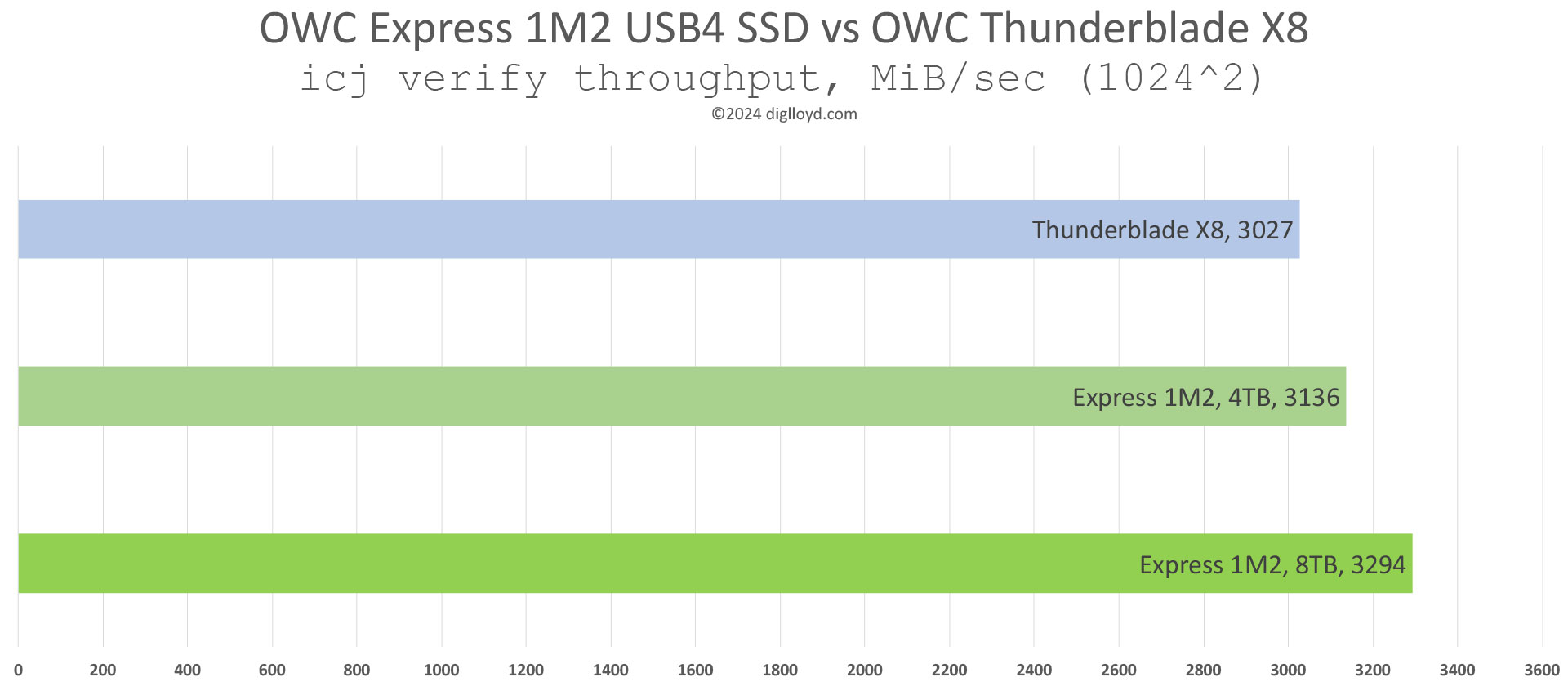
Conclusions
OWC ThunderBlade X8 is a fantastic professional-grade offering that cannot be beaten for its features and performance and capacity*. Highly recommended!
The key value propositions are:
- True professional grade build quality including hardshell travel case.
- Impeccable Thunderbolt performance for both reading and writing.
- 16TB and 32TB capacity options in an external SSD.
- Fault tolerance option via RAID-4/5.
- Totally silent — no fan.
Were cost/budget not an issue, I’d gladly switch to a 32TB OWC ThunderBlade X8 as my primary data store on my 2023 Mac Pro M2 Ultra. The 16TB unit would be equally attractive except that my current data is around ~18TB, so it’s just a bit small with no room for growth.
The 8TB value proposition
I make one exception to the above with respect to the 8TB capacity model only: for my uses and needs, the 8TB OWC Express 1M2 USB4 SSD is not only a bit faster, but bus-powered (no bulky external power supply and cables), and much smaller/lighter. All in all a far better match for my travel needs.
But the Express 1M2 cannot be daisy-chained, and is limited to 8TB capacity. And the 1M2 has no fault tolerance capability—but I don’t care about in my scenarios, since I make backups and/or the 1M2 is itself a backup.
Finally, the ThunderBlade X8 is not all that cost effective per TB in its 8TB capacity. The 16TB model is notably better on $/TB capacity, at much less than 2X the price. Which makes it a far better long term value if your data is going to grow past 8TB.
* Excepting an internal non-portable PCIe SSD applicable to a Mac Pro or PC with slots.
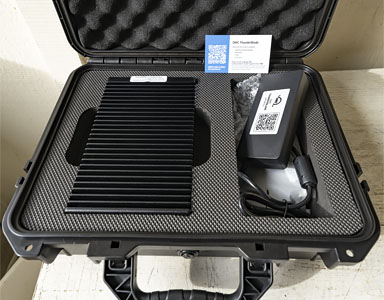
Seagate 22TB IronWolf Pro 7200 rpm SATA III 3.5" Internal NAS HDD (CMR)
SAVE $100

 diglloydTools™
diglloydTools™

